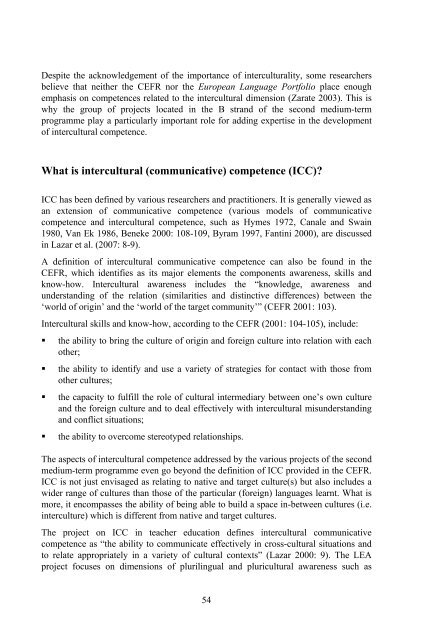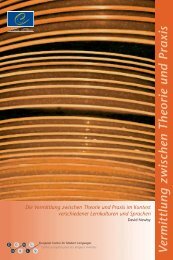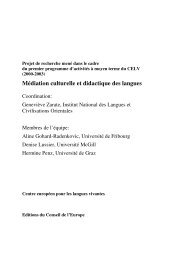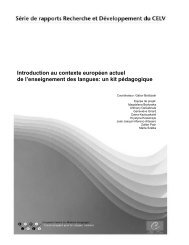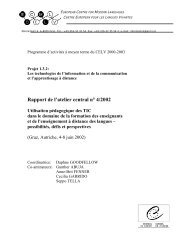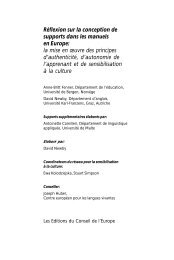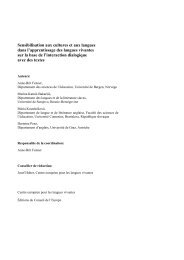cohesion - European Centre for Modern Languages
cohesion - European Centre for Modern Languages
cohesion - European Centre for Modern Languages
You also want an ePaper? Increase the reach of your titles
YUMPU automatically turns print PDFs into web optimized ePapers that Google loves.
Despite the acknowledgement of the importance of interculturality, some researchers<br />
believe that neither the CEFR nor the <strong>European</strong> Language Portfolio place enough<br />
emphasis on competences related to the intercultural dimension (Zarate 2003). This is<br />
why the group of projects located in the B strand of the second medium-term<br />
programme play a particularly important role <strong>for</strong> adding expertise in the development<br />
of intercultural competence.<br />
What is intercultural (communicative) competence (ICC)?<br />
ICC has been defined by various researchers and practitioners. It is generally viewed as<br />
an extension of communicative competence (various models of communicative<br />
competence and intercultural competence, such as Hymes 1972, Canale and Swain<br />
1980, Van Ek 1986, Beneke 2000: 108-109, Byram 1997, Fantini 2000), are discussed<br />
in Lazar et al. (2007: 8-9).<br />
A definition of intercultural communicative competence can also be found in the<br />
CEFR, which identifies as its major elements the components awareness, skills and<br />
know-how. Intercultural awareness includes the “knowledge, awareness and<br />
understanding of the relation (similarities and distinctive differences) between the<br />
‘world of origin’ and the ‘world of the target community’” (CEFR 2001: 103).<br />
Intercultural skills and know-how, according to the CEFR (2001: 104-105), include:<br />
the ability to bring the culture of origin and <strong>for</strong>eign culture into relation with each<br />
other;<br />
the ability to identify and use a variety of strategies <strong>for</strong> contact with those from<br />
other cultures;<br />
the capacity to fulfill the role of cultural intermediary between one’s own culture<br />
and the <strong>for</strong>eign culture and to deal effectively with intercultural misunderstanding<br />
and conflict situations;<br />
the ability to overcome stereotyped relationships.<br />
The aspects of intercultural competence addressed by the various projects of the second<br />
medium-term programme even go beyond the definition of ICC provided in the CEFR.<br />
ICC is not just envisaged as relating to native and target culture(s) but also includes a<br />
wider range of cultures than those of the particular (<strong>for</strong>eign) languages learnt. What is<br />
more, it encompasses the ability of being able to build a space in-between cultures (i.e.<br />
interculture) which is different from native and target cultures.<br />
The project on ICC in teacher education defines intercultural communicative<br />
competence as “the ability to communicate effectively in cross-cultural situations and<br />
to relate appropriately in a variety of cultural contexts” (Lazar 2000: 9). The LEA<br />
project focuses on dimensions of plurilingual and pluricultural awareness such as<br />
54


